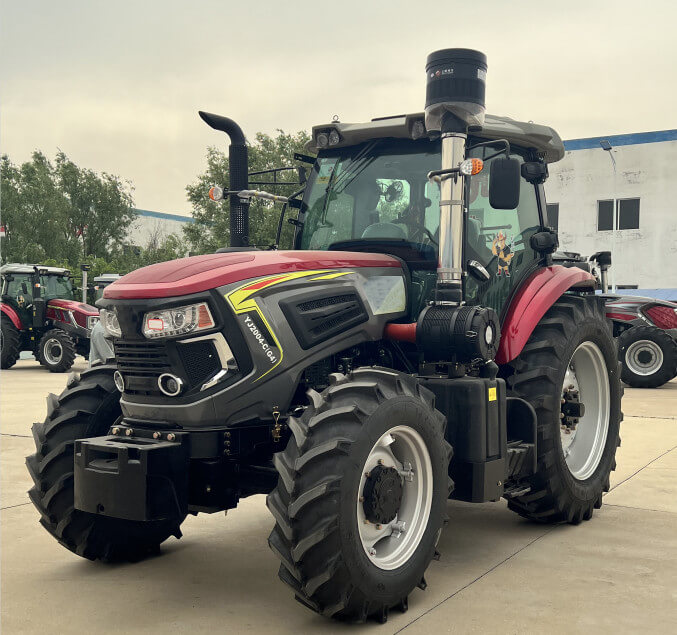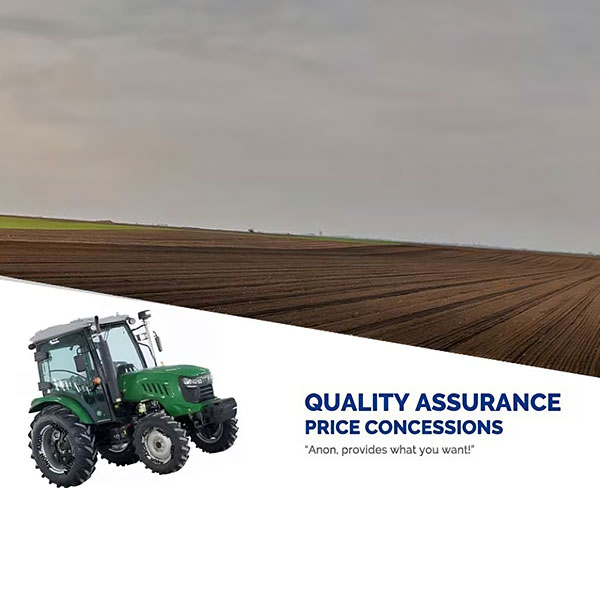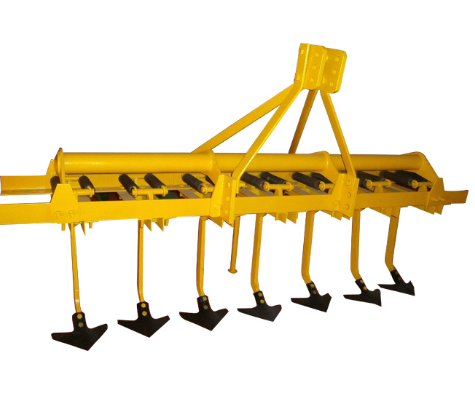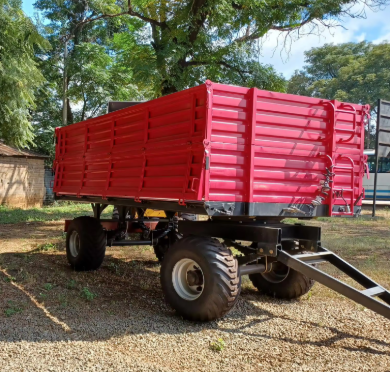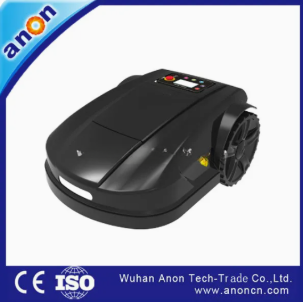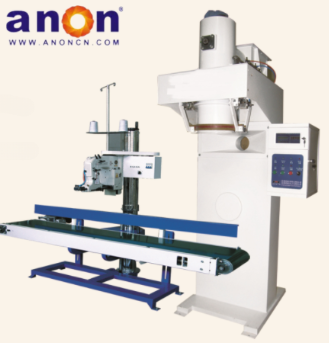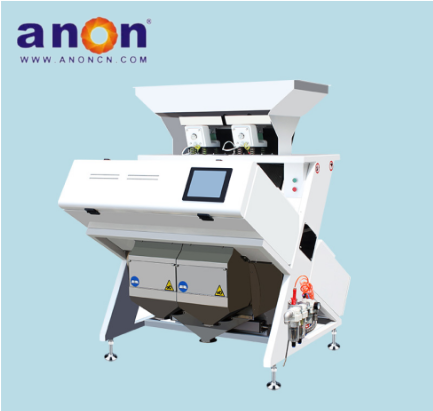
Introduction
A tractor is a machine used to pull or provide power to tools that don’t have their own power. It is widely used in both industry and agriculture.
In farming, whether you have a small or large farm, having a tractor is a smart choice. It can be a helpful assistant. Besides moving materials, tractors can work with different attachments to help you with plowing, planting, fertilizing, and harvesting.
However, there are many types of tractors on the market, and not all can do these tasks. Do you know the differences between them? Don’t worry! In the following article, I will explain the common types of tractors to help you choose the right one for your needs, so you can work more efficiently.
Types of tractors
Based on a walking device
Wheeled Tractor
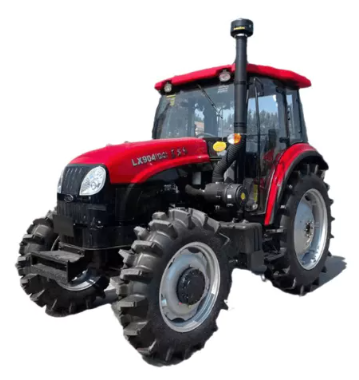
A wheeled tractor is a tractor that moves using wheels instead of tracks. It has strong traction and is suitable for dry field operations such as plowing, planting, and harvesting. It can also be used for loading and transporting goods.
The engine is the main power source that drives a wheeled tractor. The engine generates power, which passes through the transmission system and finally reaches the drive wheels as driving torque. The drive wheels push against the ground using tire treads and the contact between the tires and the ground. They apply a small backward horizontal force, called tangential force.
According to the law of action and reaction, the ground pushes back with an equal force in the opposite direction. This reaction force is the driving force that moves the tractor forward. The tractor can only move forward when the driving force is strong enough to overcome the rolling resistance of the front and rear wheels, as well as the draft force from the attached implements.
Wheeled tractors come in two main types: two-wheel drive (2WD) and four-wheel drive (4WD). A 2WD tractor has smaller front wheels and larger rear wheels. The front wheels steer, and the rear wheels drive. A 4WD tractor may have equal-sized wheels or larger rear wheels. 4WD tractors have stronger traction than 2WD ones. They are better suited for pulling heavy or wide implements and for basic farmland construction.
Walking Tractor

A walk-behind tractor consists of an engine, chassis, and electrical system. It has a simple structure and low horsepower. It is suitable for farming and transportation on small plots of land.
The walk-behind tractor moves forward using power from the engine. The engine power passes through the transmission system and reaches the drive wheels as driving torque. The wheels push against the ground using the tire treads and surface. This creates a backward horizontal force. The ground reacts with an equal forward force, which drives the tractor forward.
Walk-behind tractors do not have a steering wheel. Instead, they turn using the clutches on the left and right handles. When operating, try to start without turning. On flat ground or uphill, to turn to one side, firmly hold the handle on that side to disengage the clutch. This stops the power to that wheel. When one wheel spins slower than the other, the tractor turns smoothly.
When going downhill and turning, you should grip the handle on the opposite side. This method is called “reverse steering.”
Boat Tractor

A boat-type tractor is a tractor equipped with a hull, designed for working in paddy fields. Also known as a “mechanized farming boat,” it was first developed in China to solve the challenge of operating in deep, muddy rice fields.
This type of tractor mainly consists of an engine, transmission system, braking and steering systems, walking mechanism, hull, and an implement hitch system.
The boat-type tractor works by combining mechanical power with floating support from the hull. This allows the machine to glide over the surface layer of wet, soft soil. The drive wheels generate propulsion and keep the machine moving through paddy fields, flooded fields, or swampy land.
It is well-suited for different types of rice field operations. In deep, muddy fields with poor soil support, regular wheeled tractors often sink and work inefficiently. In contrast, the boat-type tractor uses paddle-like blades on the drive wheels to dig into the soil and push the machine forward. This design solves many of the problems that wheeled tractors face when working in wet or submerged conditions.
Crawler Tractor

A crawler tractor moves using tracks instead of wheels. It is mainly used for field operations on heavy, sticky soil and wet land, especially for basic farmland construction. However, it is not suitable for transportation tasks.
Crawler tractors have low ground pressure. By increasing the contact area with the ground, they reduce the pressure on the soil. This allows them to perform well in wet and soft ground conditions. When the tracks touch the ground, their lugs dig into the soil, which prevents slipping and increases traction efficiency.
Crawler tractors can handle complex terrain. They are more stable than wheeled tractors on uneven land. On steep slopes or bumpy ground, wheeled tractors tend to slip, while crawler tractors move steadily and ensure high-quality tillage work.
Crawler tractors are also easier to steer and turn, allowing for more precise operations. By adjusting the track width and depth, these tractors can adapt to different land types, including wetlands, hard soil, and sandy ground. This gives farmers more flexibility and convenience in their work.
Based on power
Sub-compact tractor
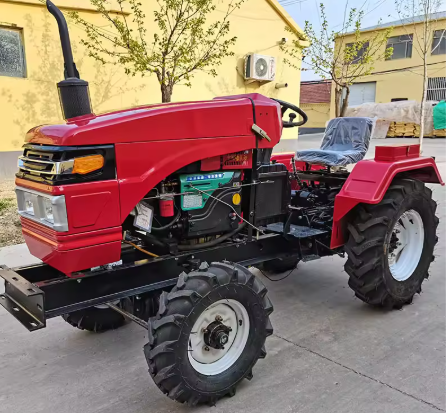
A sub-compact tractor generally refers to tractors with less than 20 horsepower, which are small in size, very compact in structure, low in height, and narrow in width. Usually open driving. It is suitable for large courtyards, small farms, or scenarios that require various maintenance work.
The advantage of the subcompact tractor lies in its versatility, which can connect various accessories to achieve different functions, such as connecting lawn mowers for grass cover and being a powerful tool for mowing large indoor courtyards. It can also use the three-point suspension and power output shaft at the rear to drive the rotary tiller to maintain the fields, and be paired with a snow blower for winter snow cleaning or to transport heavy objects through the front loader. In small farms or orchards, subcompact tractors can be used for light hauling, fertilizing, and other operations.
Compact tractor
A compact tractor is a tractor with an engine power of less than 25 horsepower. It has a simple and compact design, is easy to operate, lightweight, and relatively low in cost. It is also easy to maintain, making it a versatile and practical option for many users.
Small tractors are suitable for both dry and wet field work in plains, hills, and mountainous areas. They can also be used as stationary power sources. Many models come with lighting equipment, so you can operate them even at night.
Some small wheeled tractors offer high torque reserves and good fuel efficiency.
These tractors are ideal for working on small plots of land. They can handle tasks such as plowing, planting, fertilizing, and mowing. They are also perfect for use in orchards, greenhouses, and other tight spaces. Thanks to their small size and flexible operation, they are great for lightweight farming, lawn care, and small-scale transport jobs.
Medium tractor

A medium-sized tractor has an engine power between 25 and 100 horsepower. It features a modern design, with a compact structure and a small footprint, making it easy to operate in tight or narrow farmland spaces.
Medium tractors are ideal for medium-sized farms. They can efficiently handle tasks such as plowing, soil preparation, seeding, and fertilizing, while offering flexible operation. These tractors can also perform harvesting tasks effectively, helping to improve overall farming efficiency.
In addition, medium-sized tractors are well-suited for transport work. They can pull small trailers to move agricultural materials within fields or rural areas. When paired with various implements—such as mowers, they can complete more complex agricultural tasks with ease.
Large tractor
A large tractor is defined as having an engine power between 100 and 200 horsepower. It is equipped with a high-power engine that delivers strong output, meeting the demands of large-scale farming. It can efficiently handle heavy-duty tasks such as deep plowing and subsoiling.
Large tractors typically feature more than 10 gear options in a two-point gear system. Using the appropriate controls, the operator can select the right gear to match different implements and tasks.
These tractors are ideal for foundational work on large farms. They can efficiently tow large seeders, combine harvesters, and other heavy equipment, ensuring smooth, large-scale operations. On medium-sized ranches, large tractors can also be used for mowing, hauling, and silage-making, helping improve productivity in livestock management.
Based on Purpose
Garden tractor
A lawn tractor is a compact tractor specially designed for yard and garden work. It is primarily used for mowing and landscape maintenance. Compared with a regular lawn mower, a lawn tractor is more powerful and better suited for large lawns and estates, making it an indispensable helper for maintaining expansive gardens.
The core function of a garden tractor is mowing. By towing a rotary mower, it can quickly cut large areas of grass with far greater efficiency than a traditional walk-behind mower. When equipped with a grass collector or leaf vacuum, it efficiently gathers leaves and clippings from the lawn.
In winter, it can be used with a snow blower or snow plow attachment to clear driveways and paths. It can also be paired with different implements for hauling tasks or even light tillage work, adding versatility throughout the year.
Orchard Tractor
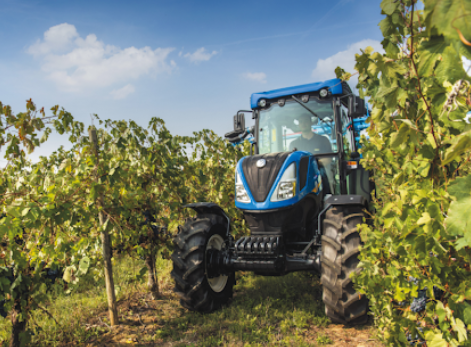
An orchard tractor is specially designed for working in orchards, vineyards, nurseries, and other specialized planting environments. It is distinctly different from standard agricultural or garden tractors, as its design is optimized for maneuvering in narrow, low-clearance rows while protecting crops.
Its most notable features are a low profile and compact structure, allowing it to move easily beneath tree canopies without damaging fruit. Orchard tractors are also narrower than conventional tractors of the same horsepower. With adjustable track width and ground clearance, they can be adapted to different tree species and orchard layouts.
Row Crop Tractor
A row crop tractor is one of the most common, important, and specialized types of agricultural tractors. It is specifically designed for the planting, cultivation, and harvesting of row-planted crops. The primary purpose of a row crop tractor is to efficiently perform all field operations throughout the crop growth cycle without damaging the plants.
These tractors are ideal for crops typically planted in neat rows, such as corn, soybeans, cotton, sorghum, and potatoes. They feature adjustable wheel spacing to ensure the tires run precisely between crop rows, and a high ground clearance that prevents crops from being trampled or damaged.
Utility Tractor
A utility tractor is the most common and versatile type of tractor, suitable for a wide range of farm tasks. With a broad horsepower range, it offers strong traction and reliable power take-off (PTO) capabilities. Featuring a moderate ground clearance and typically equipped with a hydraulic three-point hitch system, a utility tractor can handle plowing, harrowing, seeding, and hauling. It is an indispensable workhorse for small to medium-sized farms.
How to choose your tractors
Consider the Work Requirements
Tractors are versatile machines with multiple functions, such as plowing, seeding, harvesting, and transporting. Each task requires different levels of power, traction, and maneuverability. For example, if your main task is plowing, you should choose a tractor with higher traction, more power, and sufficient torque. On the other hand, if you are working in an orchard, where space is limited, you’ll need a smaller, more agile tractor with a tighter turning radius.
Consider Your Land Conditions
First, consider the size of your land. This will help you decide between small, medium, or large tractors. Next, think about the soil type, terrain, and landscape of the land. For example, clay soils require tractors with greater traction. In this case, choose a tractor with higher power and strong tire grip. For operations in mountainous or hilly areas, tractors with good climbing ability, such as crawler tractors, are more suitable.
Consider Comfort and Ease of Operation
The design of the cabin is crucial. A good cabin should provide ample space, comfortable seating, an ergonomic layout, and clear visibility. The tractor should be easy to operate, with well-organized controls, handles, and buttons. Features like gear shifting, throttle, and brake should be conveniently placed for the operator.
Lastly, the operator needs clear visibility to observe the surrounding environment and work conditions. The tractor’s windshield should be wide and bright, with large rear and side mirrors for adequate visibility.
Consider Cost Factors
Prices can vary significantly between different tractor brands, models, and configurations. While you should choose a tractor that meets your operational needs, it’s also important to select one that is reasonably priced. However, price should not be the only consideration—performance, quality, and after-sales service are also important factors.
Additionally, fuel consumption and maintenance costs should be considered. Fuel is one of the main expenses during tractor use. A tractor with good fuel efficiency will lower long-term costs. Maintenance includes regular servicing and parts replacement, and some brands have higher maintenance costs, which should also be factored into your decision.
Conclusion
After reading this article, we hope you now have a clear understanding of the different types of tractors and how to choose the right one for your needs. If you’re interested in tractors or facing any challenges, feel free to reach out to us anytime for advice or assistance!
FAQ
What is the average lifespan of a tractor?
If properly maintained, a tractor can last an average of 4,000 hours, or even as long as 10,000 hours. However, it is important to note that as a tractor ages and is used, its performance may change.


